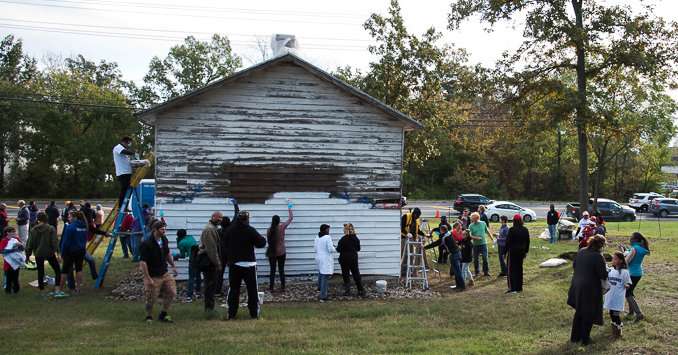The graffiti sprayed in September on the building in Ashburn, a community of about 43,000 people northwest of Washington, included swastikas, dinosaurs, sexual images and the phrases “brown power” and “white power.”
Advertisement Continue reading the main story
Two of the teenagers are white and three are minorities, the commonwealth attorney’s office said in a statement announcing the decision last week. They were arrested in October, and each pleaded guilty to one count of destruction of private property and one count of unlawful entry. At least one of the teenagers said he did not know the symbolism of a swastika.
Alejandra Rueda, a deputy commonwealth attorney who came up with the idea, said in a telephone interview on Wednesday that it was the first time in her 19-year career as a prosecutor that she has assigned a reading list as part of a disposition.
“It occurred to me that the way these kids are going to learn about this stuff is if they read about it, more than anything,” Ms. Rueda said. “Yes, they could walk into court and plead guilty and get put on probation and do some community service, but it wasn’t really going to bring the message home.”
“I just thought maybe if they read these books, it will make an impression on them, and they will stand up for people who are being oppressed,” she added.
Ms. Rueda said she had been inspired by her own history growing up in Guadalajara, Mexico, in the 1980s, when her librarian mother handed her Leon Uris’s books “Mila 18” and “Exodus” to learn about Israel and the Holocaust while she was participating in a model United Nations project.
She later went on to read Alan Paton’s “Cry, the Beloved Country,” which touched on race and injustice in South Africa.
The teenagers will also be required to write a paper about the impact swastikas and “white power” messages have on African-Americans and members of the broader community. The paper must include historical references such as Nazism, lynchings and discriminatory laws.
They must also listen to a recorded interview of Yvonne Neal, a Virginia woman who described her experiences as a student from 1938 to 1945 at the Ashburn Colored School, its official name in tax records.
“We are seizing the opportunity to treat this as an educational experience for these young men so they may better appreciate the significance of their actions and the impact this type of behavior has on communities and has had throughout history,” the commonwealth’s attorney, Jim Plowman, said in the statement.
Please verify you're not a robot by clicking the box. Invalid email address. Please re-enter. You must select a newsletter to subscribe to. Sign Up Receive occasional updates and special offers for The New York Times's products and services. Thank you for subscribing. An error has occurred. Please try again later. View all New York Times newsletters.
Some of the books on the list have been banned or challenged in the past: like “Black Boy,” the 1945 autobiography by Richard Wright; “The Handmaid’s Tale,” by Margaret Atwood; and Ms. Angelou’s book, according to the American Library Association.
Ms. Rueda said she first gave the list to defense lawyers to make sure there were no objections from the boys’ families on religious or other grounds.
“Given how fractured our country is right now,” she said, “the more people who are open minded, the better our country will be.”
Probation officers will check the work of the youths, who are public school students.
Deep Sran, the founder of the Loudoun School for the Gifted, a private school that owns the Ashburn Colored School and is renovating it to use as an education museum, said of the vandalism: “It was just profoundly disappointing. Profoundly disappointing because this building is evidence of the worst story in American history: swastikas, white power. I teach history, and at some point you think the story will end.”
Dr. Sran said in a telephone interview he was told about the vandalism in an email in October from a man who rents space on the grounds of the old schoolhouse to smoke meat overnight for his barbecue food truck business. Dr. Sran and his colleagues raced over to the school to find spray paint on the windows and the sides of the building, a sight that was particularly upsetting because students had raised money to upgrade the windows a week before.
He said the school worked with Ms. Rueda on suggestions for the book list. One of the school’s English teachers balked at the idea of using literature as punishment, inspiring the inclusion of Ms. Neal’s interview, he said.
Eventually, Dr. Sran and his colleagues pitched several options, including Wright’s “Black Boy” and Ta-Nehisi Coates’s memoir, “The Beautiful Struggle.”
“If things like this are still happening in 2016 in a very diverse county with all the resources in the world, it’s an indictment on teachers, if a 16- or 17-year-old thinks this is how you should spend a Friday night,” Dr. Sran said.
He added, “If any good can come out of this, it has to be through an effort to educate.”

ChicksDigTheWangbone on April 15th, 2017 at 13:05 UTC »
Upside of their graffiti was that it made the local headlines and the community donations to refurbish the school exploded.
Elendaro on April 15th, 2017 at 12:40 UTC »
One of these is not like the other.
MJMurcott on April 15th, 2017 at 11:53 UTC »
Certainly has a better chance of working than any other "normal" punishment.